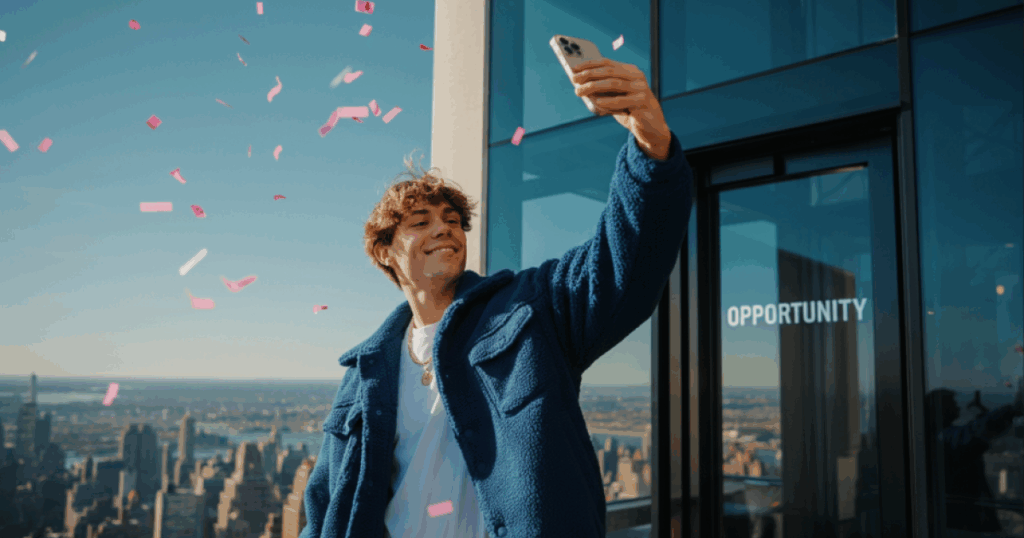Ever ask a 12-year-old Gen Alpha kid about working? To them, the peak of making money is an influencer screaming, “Hit that like button and smash that subscribe!” Do they want to work in an office? Hell no. They want to find old shoes, restore them, and then sell them to Hypebeasts who rock MSCHF items on TikTok.
According to a LEGO x Harris Poll survey, more than one in three Gen Alpha kids want to be influencers when they grow up, ranking it above doctors or astronauts. Their dream job isn’t a corner office; it’s cornering the resale market or doing a “Get Ready With Me” (GRWM) video.
But with the desire to hawk bottles of Prime, therein lies the issue: a creator can flame out if they’re not playing the long game. The creator economy has compressed the traditional fame cycle from decades to months.
They’re speedrunning it.
(For the unfamiliar, speedrunning involves completing a video game (or a specific task) as quickly as possible by utilizing advanced tricks, glitches, and optimized strategies. Players compete for world records, and games like Super Mario Bros. or Dark Souls have dedicated communities that push the limits of what’s possible.)
Creators, Start Your Engines

The creator economy is worth over $250 billion, with projections indicating it will surpass $480 billion by 2027; however, behind that viral voodoo lies a brutal churn rate. Creators launch digital empires from their bedrooms, but many burn out as quickly as they blow up.
Take the case of Taylen Biggs, a Miami-based teen influencer who built a fashion commentary brand that earned partnerships with Puma, Steve Madden, and a spot at Paris Fashion Week — only to see her audience growth flatline. Brand deals dried up in under two years.
It’s a familiar arc: overnight success, algorithmic overexposure, and no roadmap when the attention shifts. In the creator economy, you can scale faster than ever, but disappear just as quickly.
The New Velocity of Fame

You must pay your dues for every other career path, experience things, and grow from failures. For anyone in music or the arts (writing!), it takes years and years of grinding compared to today’s viral shortcuts.
TikTok and YouTube Shorts have smashed the timeline of fame to something almost cartoonish. A single 15-second video can reach millions overnight. According to TikTok’s internal data, over 70% of its users say they’ve discovered a new creator in the last week, and 83% of viral videos are made by accounts with fewer than 100,000 followers.
YouTube Shorts crossed 50 billion daily views in 2023, rewarding creators not for depth but for rapid-fire engagement. The result is a creator class built not on slow, steady growth but on sudden, algorithm-fueled exposure. Yet, most of us can barely remember what we had for lunch on Monday.
Fast fame comes at a cost. “We’re giving kids a global stage before they have the emotional infrastructure to handle it,” says Taylor Lorenz, tech and culture reporter and author of Extremely Online. “They go from anonymous to everyone-in-your-DMs in days, and there’s no off switch.” That intensity has fueled a wave of creators dealing with burnout, anxiety, and identity confusion, especially when the numbers that defined their worth begin to dip.
Some are teenagers fielding brand deals and hate comments in the same hour. Others are adults navigating the emotional whiplash of peaking at the exact moment they realize they have no backup plan — big whoops.
Consider Khaby Lame, who went from an unemployed factory worker to the most-followed TikToker on Earth in under two years despite never saying a word in his videos. He’s the dude who just shrugs and points at stuff. Wild that he makes a living, but so does a guy named Yung Gravy.
Or Jalaiah Harmon, who created the Renegade dance that powered TikTok’s early growth, only to be overlooked while others profited. Doggface208 gained fame by riding a skateboard and drinking Ocean Spray while listening to Fleetwood Mac. He hit millions of views overnight, but by year two, he was struggling to convert them into sales.
In the attention economy, metrics define momentum:
- Follower count
- Engagement rate
- And CPM (cost per thousand)
Fame has become quantifiable, trackable, and endlessly gamified. But what the numbers don’t capture is the drop-off.
The Infrastructure of Instant Celebrity

There are a dizzying number of doors that can open with a windfall of brand deals, attention, and clicks. Social agency enables rapid fame, as platforms seek more content, agencies strive to represent creators, and opportunities emerge for monetization. The algorithms change constantly, and with those changes, creators fight to stay ahead by ensuring they’re on top of what their fans want to see.
At the center of the creator industrial complex are agencies like Whalar, Underscore Talent, and Next Step Talent — firms that don’t just manage influencers; they scale them like startups. These agencies offer more than just brand deals; they build infrastructure, including merch lines, podcast production, ghostwritten books, and personal videographers on retainer. The strategy is to treat creators as multi-platform IPs, not personalities.
However, this model only works if the views continue to roll in. “You can have a team of ten behind you, but if the algorithm turns off the faucet, the empire dries up overnight,” says a former executive at a top digital talent firm. Careers live and die by the whims of platforms. One tweak to Instagram’s Reels discovery tab, a demotion in TikTok’s FYP, and a creator pulling six figures a month can scramble for engagement within weeks.
To hedge against that volatility, talent firms lean into collab houses and creator collectives — engineered ecosystems where influencers share space, shoot content together, and algorithmically boost one another through proximity and cross-promotion. The Hype House and Sway LA were distribution hubs optimized to hack virality. Behind the scenes, platforms like TikTok and Instagram also play a part, often tipping the scale. Creators and managers report “mystery boosts” after signing brand deals or participating in official campaigns.
The platforms won’t confirm it, but the logic is clear: virality isn’t random; it’s curated, incentivized, and, in some cases, engineered. In an ecosystem where visibility equals value, the algorithm isn’t just a tool — it’s the puppet master. (Cue Metallica.)
The Hype House Broke TikTok — Now It’s Breaking the Influencers Inside

The Hype House, one of the most prominent early TikTok creator collectives, began in December 2019 in a Spanish-style mansion in Los Angeles. It was basically Gen Z’s entrance into trashy reality television. Its founding members included Chase Hudson (Lil Huddy), Thomas Petrou, Daisy Keech, and Charli D’Amelio.
The house operated as both a living space and a content factory, with members required to produce a minimum number of videos daily. By early 2020, internal disputes led to fractures, with Daisy Keech leaving to form a rival house called “The Clubhouse” after claiming she was being denied proper credit as a co-founder. This established the pattern of creator-house drama that would become a distinct content genre in its own right.
While exact figures vary, recent data supports the estimate that running a mid-tier creator house in Los Angeles can cost between $80,000 and $125,000 per month. High-end rental properties alone can command $20,000 to $40,000 monthly—like Rashida Jones’s West Hollywood cottage listed at $11,000, or Walt Disney’s former home re-listed at $40,000. On top of rent, expenses often include staff salaries, production equipment, and talent incentives. Platforms like Peerspace list content house rentals in L.A. ranging from $65 to $150 per hour, reinforcing how costly professional-grade spaces can be. When you factor in everything needed to keep content flowing—from gear to payroll—the high five-figure monthly range tracks with industry realities.
The ROI analysis from the same study found that 62% of creator houses established between 2020 and 2021 had dissolved within 14 months of formation, with financial unsustainability cited as the primary reason by former members.
The Economics of Accelerated Success

Sponsorships are still what’s up, though, with mid-tier creators (those in the 50K–500K follower range) charging $500 to $10,000 per post, depending on reach and niche. But platform payouts? Wildly unpredictable. YouTube might give you $3–$5 per 1,000 views, while TikTok’s Creator Fund coughs up a measly $0.02–$0.04 per 1,000 views. That’s why more creators are shifting toward stuff they control — memberships, affiliate links, and digital products.
Case study: from viral hit to sustainable income
Let’s talk about GamingWithJen, a Twitch streamer who blew up in 2020 after a clip went viral. At first, 90% of her income came from Twitch subs and donations. But that kind of momentum doesn’t last forever. As things cooled off, she smartened up — bringing in sponsorships (30% of her income), launching merch (20%), and optimizing old streams for YouTube AdSense (15%).
By 2023, Twitch was just 35% of her pie. She’s not alone — data from the Creators Guild shows that 60% of full-time creators only hit real sustainability after adding three or more income streams.
Her lesson? Going viral is cute, but long-term success means thinking like a business.
VC money’s creator economy crush
In 2023 alone, investors dropped over $5 billion in creator-focused startups (shoutout to Crunchbase for that stat). They’re backing everything from monetization tools like Kajabi and Stir to community hubs like Discord and Circle to full-blown creator-led brands. Andreessen Horowitz’s report flagged that 70% of creators making between $50K–$500K/year need real infrastructure behind the scenes — accounting, data, and scalable systems.
Still, not all that glitters is Series A gold. Critics say this is déjà vu from the 2021 influencer app bubble, where hype outpaced demand and many startups folded. Are the ones still standing? Patreon and Shopify are companies that fix real pain points like payments and merch without the growth-bro fantasy.
Creators as accidental entrepreneurs
Here’s a wild stat: a 2024 Harvard Business Review study found that 54% of full-time creators had zero business training when they started. Fast forward, and 82% are handling contracts, taxes, and hiring staff. The tools help — Canva, ConvertKit, and Stan Store make it easier to operate like a brand. But fast growth means real stress.
About 30% of creators reported serious cash flow issues from unpredictable income.(From the same HBR study.) What’s working? Setting up an LLC early, saving ahead, and treating that bag like a business. Just look at MrBeast — dude reinvests his revenue into candy bars, ghost kitchens, and YouTube production like he’s building Disney for Gen Z.
(My kids made me get his burgers, and after a cool $50 on mediocre Wendy’s-like food, you gotta give to the guy, he’s created an empire. My wallet was not happy.)
Is the Creator Economy Built to Last?

Algorithms giveth, algorithms taketh away. One tweak to TikTok’s For You Page or Instagram’s Reels strategy, and your views—and income—can vanish overnight. According to a 2023 report by Kajabi, only 6% of creators earn more than $100,000 a year, while the vast majority make less than $10,000 annually—highlighting just how top-heavy and unpredictable the creator economy really is.
But those building their own assets — like email lists, Shopify stores, and private communities — report 2–3x higher retention than creators relying solely on platform algorithms. As Wharton’s Ethan Mollick put it: “The next wave won’t be about going viral — it’ll be about owning the infrastructure around your brand.”
Translation? Stop chasing trends. Build something you control.
The Collapse: When Fame Outpaces Infrastructure

There’s a push-and-pull paradox of being a creator: You’re trying to be chronically online while also trying not to burn out. The balance is delicate. Because there’s so much going on, creators are losing their marbles. Therapists now work with influencers to help them balance their lives and online presence.
Elle Mills stepped back from YouTube after a meteoric rise left her emotionally wrecked, and Jacksepticeye, who addressed needing breaks to protect his mental health, illustrates how constant content demands and algorithm pressure can grind even the most successful creators into dust. Twitch titan Pokimane has stepped back multiple times, citing the nonstop need to be “on” as deeply draining.
Therapist Kati Morton, specializing in influencer mental health, explains, “These careers often skip the gradual growth phase where people learn to manage stress, boundaries, and criticism. It’s like emotional speedrunning — no time to build resilience before the pressure hits.”
Add content fatigue and parasocial fallout, and it becomes a perfect storm. Fans form one-sided relationships with creators and expect constant access, attention, and emotional transparency. When creators take a break — or worse, falter publicly — those same fans can become hostile or obsessive.
Meanwhile, even minor algorithm changes can destroy engagement overnight, nuking income and relevance in a single update. Unlike traditional careers, there’s no roadmap or support system for creators navigating fame at hyperspeed. And that’s a big problem: everyone is always stressed about money, and when someone’s income suddenly gets stripped away, what do you do?
If someone made a career playing Grand Theft Auto, how can you expect that person to pivot to selling paint overnight?
The Evolution of Creator Career Longevity

We’ll always have the Paul brothers. Like cockroaches in the algorithm, they’ve survived and evolved through every digital extinction event. Whether hawking hydration drinks or stepping into boxing rings with Mike Tyson, they’ve mastered the art of reinvention. (I still think that was a fixed fight.)
But their longevity isn’t only rooted in shock value; they’ve figured out how to monetize diversification. Today’s most innovative creators are taking notes. Instead of relying solely on viral content, they’re launching podcasts, products, Discord communities, and newsletters — building infrastructure so that if the algorithm leaves them behind, their fans remain plugged in.
This has opened up a new stream of people paying attention, even if they’re not at the level of a Paul brother. A creator middle class is emerging: not megastars but full-time earners with loyal audiences, diversified income, and far more stability than those chasing one-hit virality.
According to Linktree’s 2023 Creator Report, only 12% of creators earn most of their income from a single source, and over 60% say having multiple revenue streams is critical to long-term success.
Sustainability now hinges less on follower count and more on the depth of relationships.
“Community is the asset,” says Li Jin, founder of Atelier Ventures, who has long argued that creators should think more like small business owners than influencers. Those who cultivate fan trust, communicate regularly, and offer value beyond content — whether through courses, behind-the-scenes material, or direct interaction — tend to outlast the flash-in-the-pan stars.
Experts predict that the next phase of the creator economy won’t be about chasing TikTok fame but about owning distribution. Things like:
- Mailing lists
- Monetized platforms
- And tight-knit fanbases
Things that algorithm changes can’t wipe out.
With over 50 million people worldwide now identifying as creators, the creator economy is projected to hit $480 billion by 2027, a significant amount of money. For context, that’s nearly what Apple made in iPhone sales alone last year. (Apple made ~$200B+ from iPhones in 2023.)
Redefining Success in Hyperspeed

If you’re reading this and dreaming about your social media empire, it’s best to think about the long run, not how to get followers fast. Creators should prioritize their mental health and consider how they perceive the world when they’re thought of as a cog in the larger entertainment industry. Social media fame differs from fame on the scale of music, Hollywood, and pop culture. How these forms of celebrity meet in the middle is anyone’s guess.
We’re experiencing what some call “the dead internet theory,” so how we react and interact with creators and commentators is an odd pursuit when you break it all down. (The Dead Internet Theory: most online content is generated by AI rather than humans, with the web becoming a hollow simulation maintained by algorithms and bots.)
“What we’re witnessing is the gig-ification of creativity,” says Dr. Safiya Noble, author of Algorithms of Oppression. “These platforms have masterfully externalized all risk onto creators while retaining complete control of the infrastructure that determines success. It’s a nearly perfect extraction model — they profit regardless of whether any individual creator thrives or crashes.”
So, really, what are we doing?
It’s all about keeping your head up — just don’t wind up in a creator house. Those places seem like they suck really bad unless you’re into the whole Tech Bro Fantasy Island kinda thing.
When Andy Warhol predicted everyone would be famous for 15 minutes, he couldn’t have imagined recommendation engines would parcel out those minutes, that fame would be quantified to three decimal places, or that an entire generation would shape their identities around chasing it.





